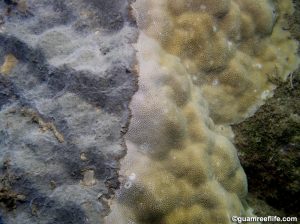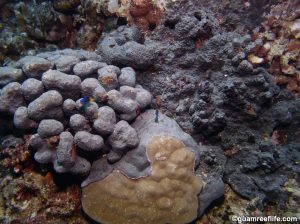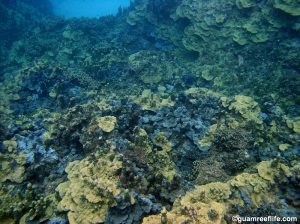Terpios hoshinota is a gray sponge that apparently can kill living coral, and can occupy large amounts of reef substrate, thereby preventing coral larvae and the larvae of other benthic organisms from settling. There have been several documented incidences of Terpios covering large sections of reef on Guam, but it is not clear how detrimental this is to the overall reef system.
Terpios is a natural part of Guam’s coral reef ecosystem, and is not considered an invasive species. But it might be appropriate to call it a “nuisance” species – one that can become detrimental to the reef ecosystem, particularly when influenced by human activities. As with most sponges, Terpios feeds on nutrients and organic matter in the water column, so a concern would be that if the amount of organic matter and nutrients in the water column is greater than normal – say, as a result of sewage discharge or stormwater runoff – than one might expect greater Terpios abundances. This is only a hypothesis, however, and has not been tested. Another hypothesis for the perceived increase in Terpios may be that it is simply occupying the large areas of reef once occupied by coral – coral which had been killed by crown of thorns sea stars or some other stressor. Still, observations of the sponge actively encroaching living coral tissue and the occupation by the sponge of large areas of reef are causing some unease among reef managers.
As with most of these threats, reports of large amounts of Terpios by fishermen, divers, and snorkelers would be of great help to the reef managers and researchers trying to understand the impact of Terpios on Guam’s reefs.



